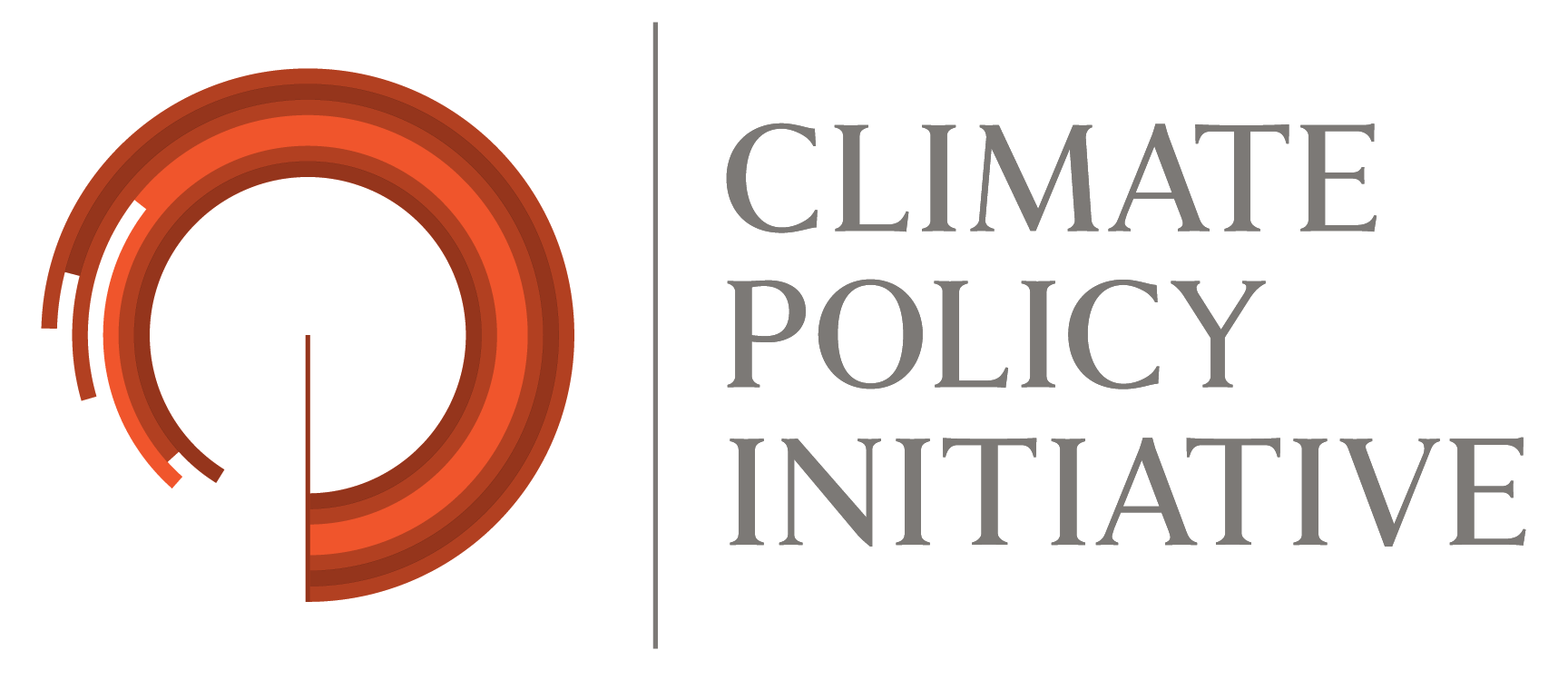Introduction
Tropical forests play a central role in the global climate agenda. They store vast amounts of carbon, regulate rainfall and water cycles, harbor some of the planet’s richest biodiversity, and sustain the livelihoods of millions of people. Their degradation and destruction undermine climate stability and pose global economic risks.
Among these forests, the Brazilian Amazon stands out both for its importance and for its growing vulnerability. The forest ensures water security for key economic sectors in Brazil, including agriculture, energy, and urban water supply, and influences climate patterns across much of South America.[1] Yet, it faces mounting human anthropogenic pressures: about 14% of the original forest had already been cleared by 2023, while remaining areas continue to suffer degradation from fires driven by illegal logging.[2],[3] Over the past 35 years, deforestation has reduced regional rainfall by approximately 21 mm per dry season, accounting for about 74% of the total decline.[4] These trends weaken the ecological balance and bring the Amazon closer to a tipping point. Safeguarding the forest is therefore both a climate imperative and an economic priority for Brazil.
In this report, researchers from Climate Policy Initiative/Pontifical Catholic University of Rio de Janeiro (CPI/PUC-RIO) and the Amazon 2030 project demonstrate how forest restoration can drive economic growth in the Amazon, transforming degraded areas into opportunities for revenue and sustainable development. The analysis finds that restoring these degraded lands through natural regeneration alone could capture up to 26 GtCO2. The study also explores the potential application of the Reversing Deforestation Mechanism (RDM) in the Brazilian Amazon, a jurisdictional mechanism developed by CPI/PUC-RIO to remunerate net tons of carbon captured.[5]
The findings further underscore the scale of the economic opportunity: over a 30-year horizon, RDM could mobilize up to US$ 784 billion in the Brazilian Amazon at a price of US$ 50 per ton of CO2. This level of investment could reshape land use, aligning higher agricultural productivity with forest restoration and delivering lasting climate and economic benefits.
By aligning policies and finance around restoration, Brazil has a chance to accelerate a profound transformation in the Amazon. Existing financial mechanisms do not adequately support restoration at scale. The RDM offers a pathway to bridge this gap. Through such innovation, Brazil can strengthen its leadership on climate action ahead of COP30 in Belém and turn restoration into a driver of economic growth and a source of value for its greatest natural asset: the Amazon forest.
Potential for Emissions Reduction and Carbon Sequestration in the Amazon
The Amazon biome covers more than 420 million hectares in Brazil, nearly half of the country’s territory. Between 1985 and 2024, almost 60 million hectares were deforested, and around 290 million hectares of forest currently require protection.
The Amazon is far from homogeneous: the biome encompasses both ecological and productive diversity that differ in their capacity for carbon capture potential and agricultural suitability. Certain areas, due to their biological and soil characteristics, have a high capacity to store carbon, acting as major carbon sinks. Other areas are better suited for agricultural production, especially cattle ranching, which has historically been the main driver of deforestation.
As shown in Figure 1, these two functions rarely overlap. Areas with high carbon capture potential tend to have lower agricultural productivity, while those most suitable for agriculture and livestock tend to have lower carbon sequestration capacity. This spatial heterogeneity presents a strategic opportunity: by optimizing land use in the Amazon, it is possible to increase agricultural production in cleared areas while conserving and restoring forests in others—maximizing both economic returns and climate benefits.
Figure 1. Carbon Sequestration Parameters and Variation in Agricultural Productivity in the Brazilian Amazon
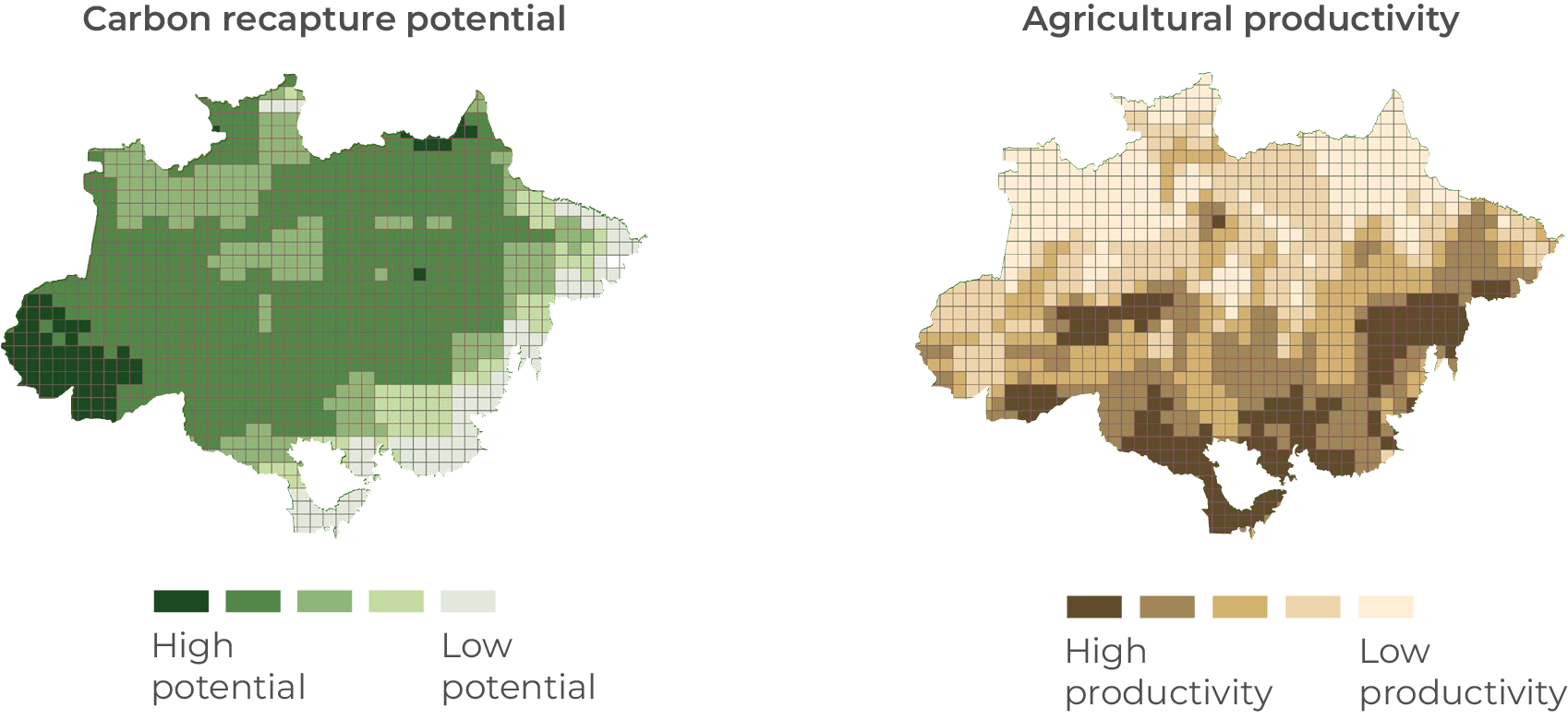
Source: CPI/PUC-RIO with data from Assunção et al. (2025), 2025
This heterogenity of the Amazon, means that each state in the region faces distinct challenges and opportunities, including the amount of forest cover, deforestation dynamics, and the carbon capture potential associated with forest restoration. Figure 2 summarizes, by state and for the biome as a whole, three key dimensions for reducing Brazil’s greenhouse gas (GHG) emissions: remaining forest, cumulative deforestation, and carbon capture potential.
Figure 2. Forest Area (2024), Cumulative Deforestation (1985-2024), and Carbon Capture Potential for the States of the Brazilian Amazon
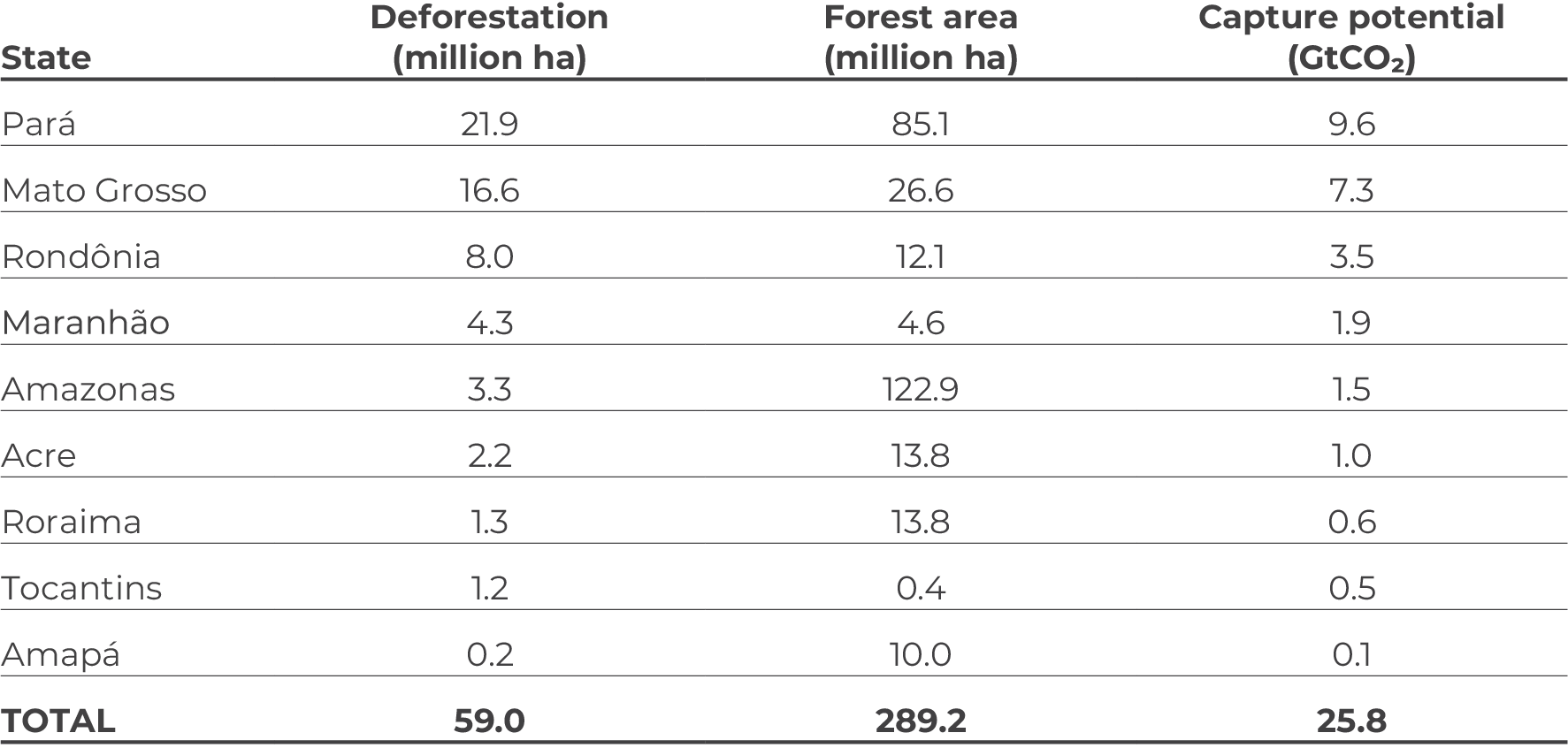
Source: CPI/PUC-RIO with data from Hansen (2023), Santoro M. and Cartus, O. (2021), and MAPBIOMAS (2025), 2025
The historical trajectory of deforestation across Brazil’s Amazon states shows alternating periods of expansion and decline. Deforestation rose steadily until 2003, declined sharply through 2010, increased moderately until 2022, and has since begun to fall again. Figure 3 illustrates these trends by state. The decreasing share of Mato Grosso in total deforestation, alongside the increasing activity in Amazonas, reflects the shifting “Arc of Deforestation”, an agricultural frontier associated with intense forest clearing. These patterns demonstrate that high deforestation rates can be reversed when robust public policies for enforcement and forest protection are consistently applied.
Figure 3. Deforestation Trajectory (1985-2024) by Brazilian State in the Amazon Biome
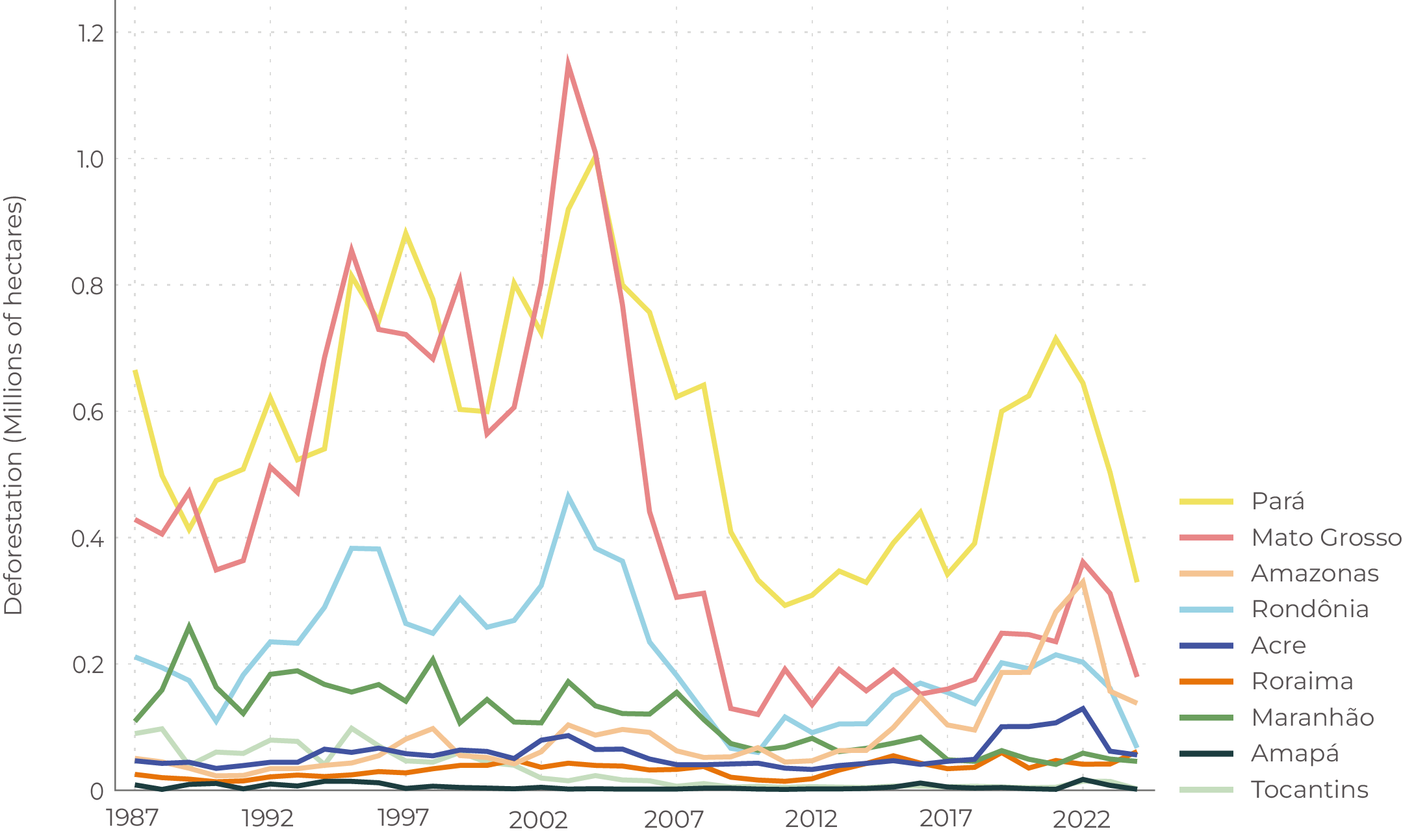
Source: CPI/PUC-RIO with data from MAPBIOMAS (2025), 2025
Differences among states help define priorities for action. Pará, with the highest cumulative deforestation, has the greatest potential for carbon capture (Figure 4). Mato Grosso is second, although its relative share of total deforestation in the biome has decreased over time. Amazonas, conversely, held the largest remaining forest area as of 2024, followed by Pará. These contrasts highlight distinct combinations of risk and opportunity: states with extensive forest cover require robust protection measures, while those with large areas of degraded land offer major opportunities for restoration and carbon capture.
Figure 4. CO2 Capture Potential of Brazilian States in the Amazon Biome
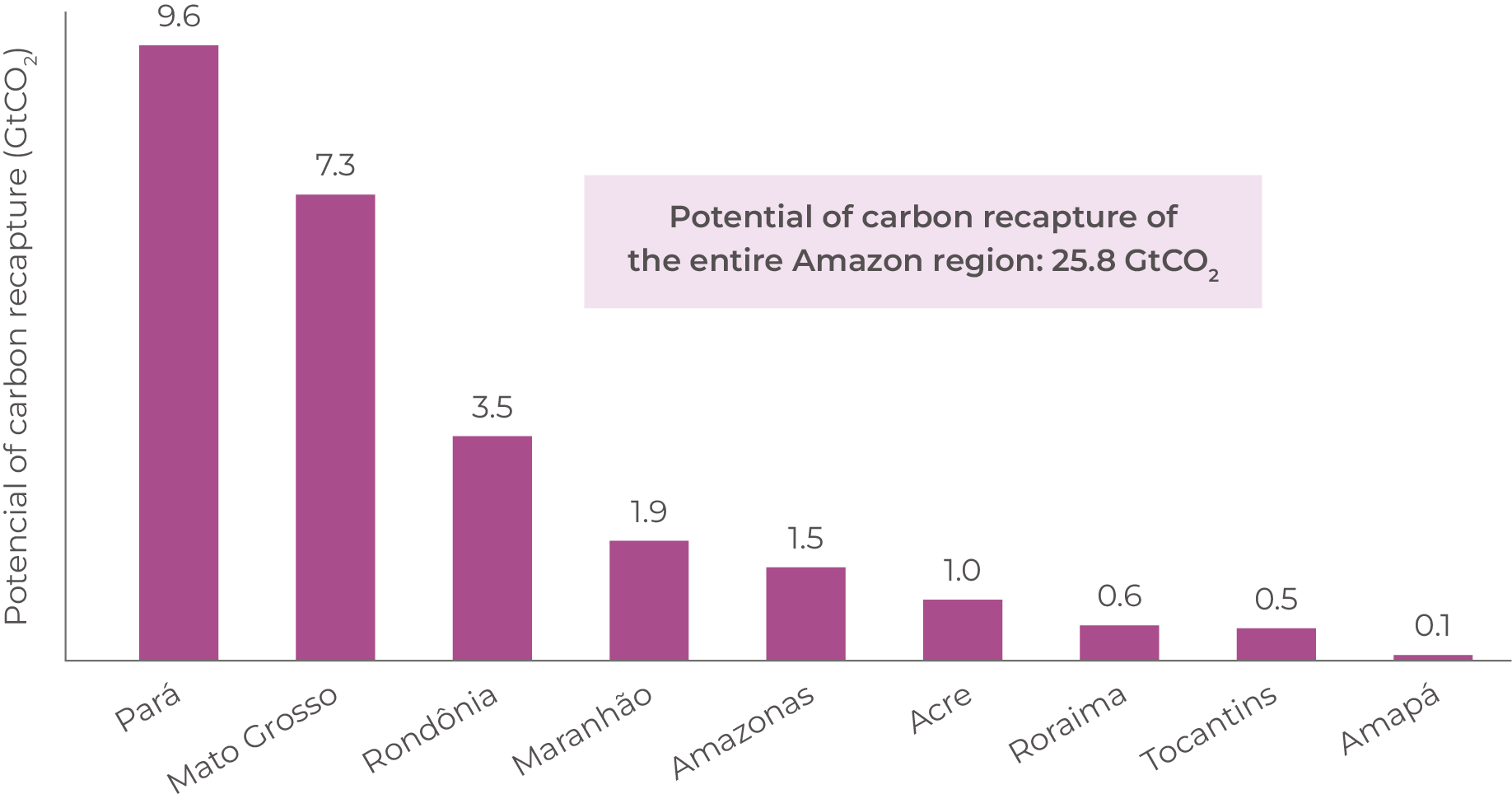
Source: CPI/PUC-RIO based on data from Hansen (2023) and MAPBIOMAS (2025), 2025
This report indicates that natural regeneration in already deforested areas could capture up to 26 GtCO2 across the Amazon region. Figure 5 breaks down this potential by state, showing how restoration opportunities are distributed over time and space. This breakdown makes it possible to assess both the timing and the climate relevance of these captures, which tend to decline over the years as forest growth stabilizes and carbon absorption decreases with ecosystem maturation. The projection assumes restoration efforts will begin in 2031, in line with the commitments made in the COP28 Global Stocktake, and presents the results in five-year intervals, aligned with the Paris Agreement’s review cycles and increased climate ambition goals.
Figure 5. Potential Annual Carbon Capture by State
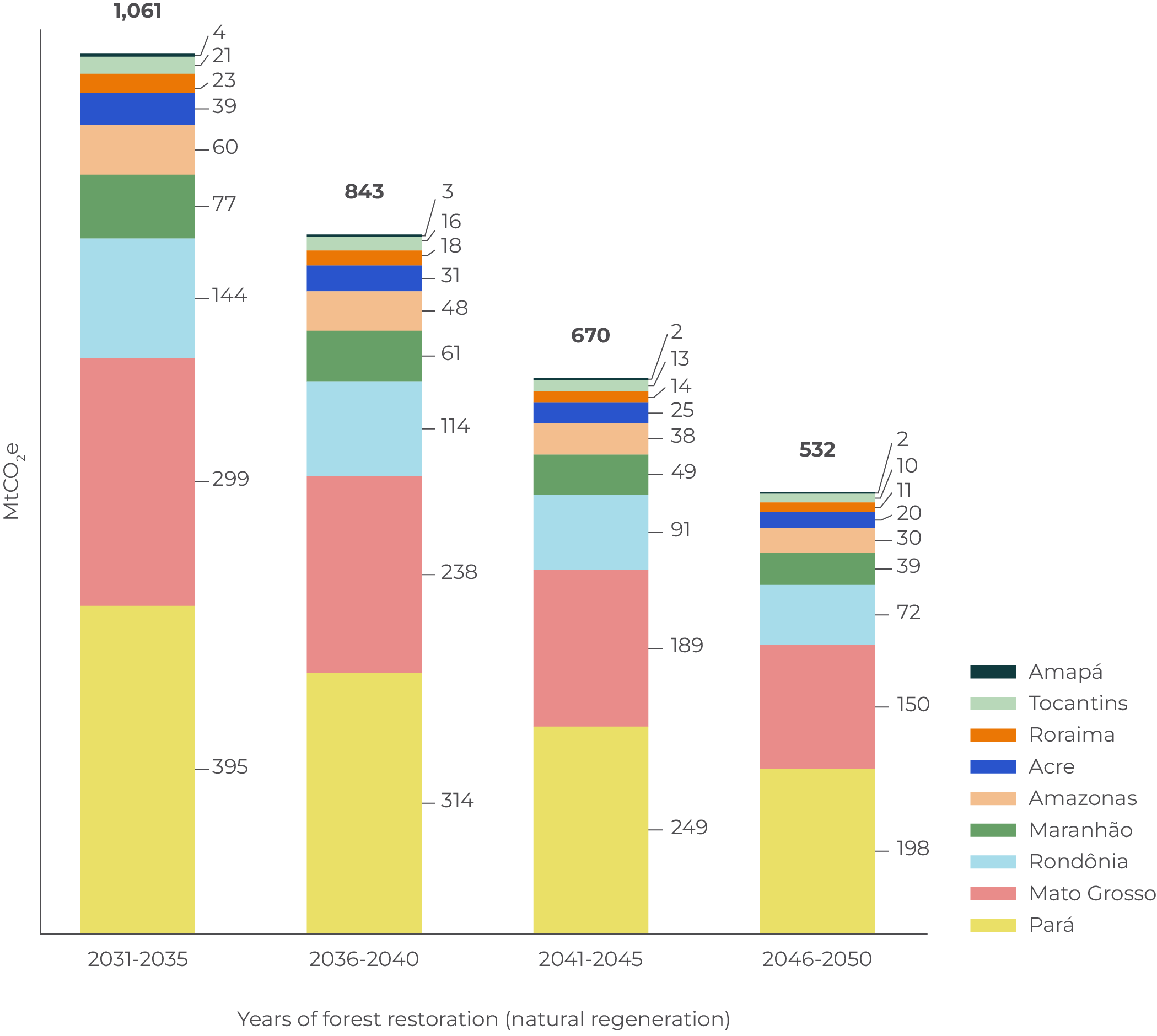
Source: CPI/PUC-RIO based on data from Hansen (2023), Santoro, M. and Cartus, O. (2021), and MAPBIOMAS (2025), 2025
Implementing the Reversing Deforestation Mechanism in Brazil
The Reversing Deforestation Mechanism (RDM), developed by CPI/PUC-RIO, is a jurisdictional, results-based payment mechanism that remunerates net carbon removals achieved through forest restoration.[6] It operates through carbon credit purchase agreements between a buyer and a jurisdiction at a pre-agreed price. The effective implementation of the RDM requires clear measurement systems, governance, and finance to ensure that carbon credits reflect net carbon capture and that the resources generated promote forest conservation and sustainable development.
The jurisdiction’s carbon credits are calculated through a robust carbon accounting system that accounts for net emissions, including the carbon captured by forest restoration each year, and subtracting emissions from deforestation and agricultural activities within the same jurisdiction.
The proceeds from these credits feed into a jurisdictional fund, whose resources are allocated according to locally defined priorities. There are incentives for jurisdictions to allocate part of the funds to activities directly linked to net carbon capture, such as land designation, the consolidation of protected areas and Indigenous lands, and payments for ecosystem services on private properties. The resources can also be used flexibly to support actions that prevent further deforestation, expand forest restoration through active restoration models, or address social needs common in developing countries, such as poverty alleviation, health, education, security, and infrastructure.
The RDM also provides mechanisms to address the challenge of permanence, which is inherent to carbon capture initiatives, by creating a permanence fund or implementing payments through a reversible debt mechanism. The choice of format depends on policy preferences and technical feasibility, but both offer viable ways to ensure the integrity and longevity of carbon credits.
To ensure scale, the RDM can be connected to international carbon markets, including the potential regulated markets provided for under Article 6 of the Paris Agreement. The international sale of appropriately priced forest restoration carbon credits could encourage additional restoration that would not otherwise occur, mainly through natural regeneration, with the potential to attract significant resources to the country and the Amazon region.
This kind of operation does not compromise Brazil’s Climate goals for 2035. In fact, the RDM can serve as a key mechanism in achieving them. The country’s new Nationally Determined Contribution (NDC) establishes a target of 59% to 67% reduction in net emissions compared to 2005, meaning that the country needs to achieve between 850 million and 1.05 billion tons of CO2 per year. However, in 2023 alone, deforestation in the country accounted for 1.06 billion tons of CO2. In this sense, the RDM offers an additional path to achieving climate goals, creating clear incentives for reducing deforestation, especially in the Amazon.
The effective implementation of the RDM requires a jurisdictional approach to avoid deforestation leakage and take advantage of economies of scale in law enforcement. It is also necessary to ensure the scale of the operation, financial feasibility, and the permanence of long-term credits, since carbon capture through forest restoration decreases as forests mature. Private sector engagement is essential, driving active restoration and investing in forest-compatible products. Figure 6 shows the proposed implementation of the RDM.
Figure 6. Implementation of the RDM
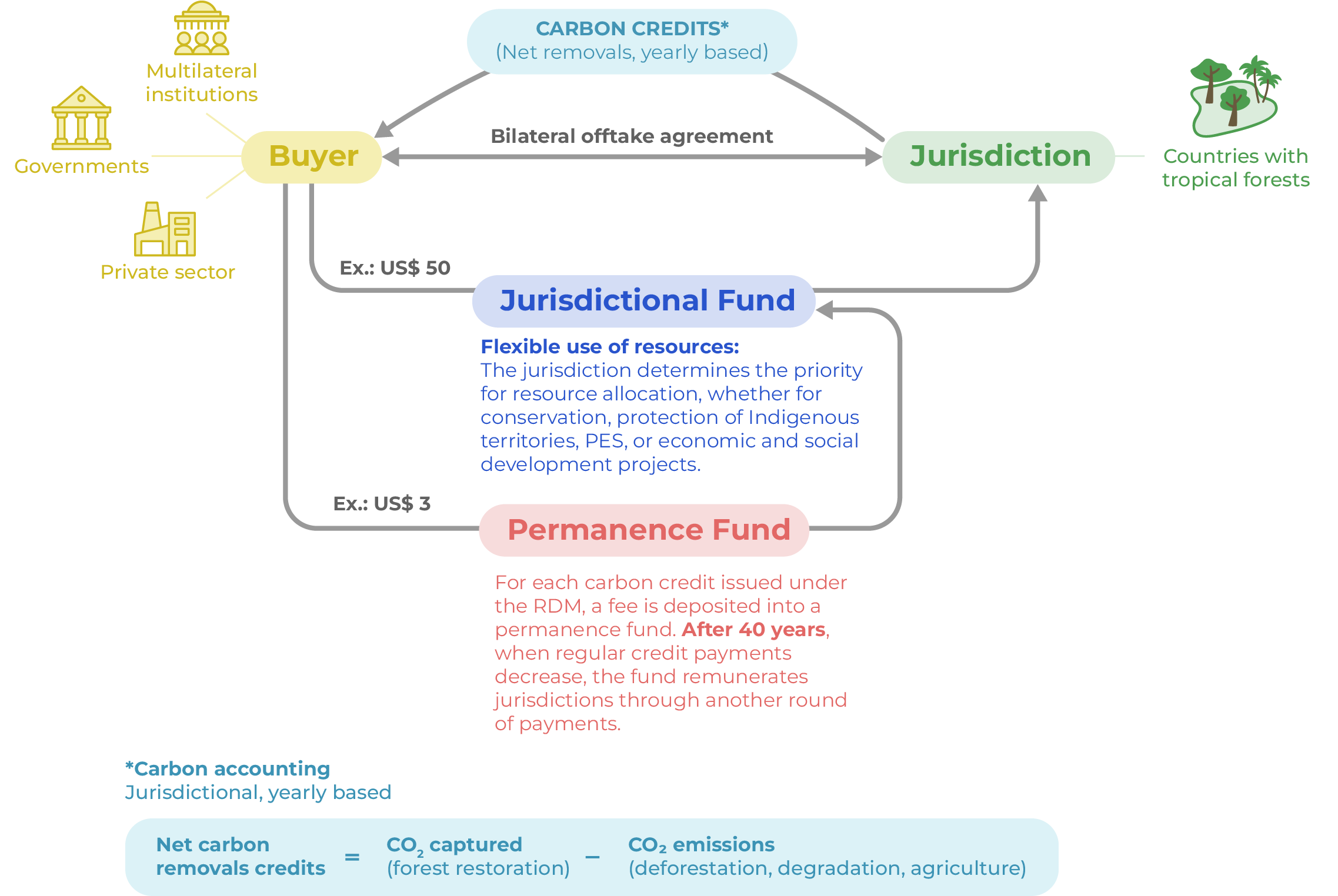
Source: CPI/PUC-RIO, 2025
Brazil already has several institutional and technical mechanisms in place to strengthen the implementation of the RDM, which can be grouped into three blocks:
- Monitoring and law enforcement: The country has advanced satellite monitoring systems, including the Real-Time Deforestation Detection System (Sistema de Detecção de Desmatamento em Tempo Real – DETER) and the Program for Monitoring Deforestation in the Legal Amazon by Satellite (Programa de Monitoramento do Desmatamento na Amazônia Legal por Satélite – PRODES), as well as complementary initiatives such as the MAPBIOMAS Brazilian Annual Land Use and Land Cover Mapping Project and the Deforestation Alert System (Sistema de Alerta de Desmatamento – SAD) of the Amazon Institute of People and the Environment (Instituto do Homem e Meio Ambiente da Amazônia – IMAZON). In addition, the national Rural Environmental Registry (Cadastro Ambiental Rural – CAR), established by the Forest Code, efficiently links rural properties to law enforcement.
- Subnational experiences and governance mechanisms: The Integrated Action Program for Sustainable Territories (Programa Territórios Sustentáveis – PTS) of the Government of Pará demonstrates the feasibility of applying the RDM at the subnational level, while the National REDD+ Strategy (Estratégia Nacional para REDD+ – ENREDD+) and the Amazon Fund have already demonstrated that the country can structure long-term carbon credits and operationalize results-based payments.[7]
- Private sector engagement: Strengthening the private forest restoration sector offers new possibilities for overcoming the limitations of natural regeneration, promoting active and technical approaches that increase the effectiveness and speed of restoration.
The RDM is directly linked to the Restoration Arc strategy, an initiative developed for the restoration of degraded areas in the former “Arc of Deforestation” in the Amazon, coordinated by the Ministry of the Environment and Climate Change (Ministério do Meio Ambiente e Mudança do Clima – MMA) and the Brazilian Development Bank (Banco Nacional de Desenvolvimento Econômico e Social – BNDES), with support from the Amazon Fund and the Climate Fund.[8] The initiative aims to capture carbon, recover 24 million hectares of forest by 2050, and generate jobs. By attracting finance for forest restoration through jurisdictional carbon capture services, the RDM can amplify local restoration efforts, while these same initiatives, in turn, reduce implementation risks associated with the mechanism itself.
Financial Mechanisms for Forests: Comparing JREDD+, TFFF, and RDM
International finance plays a central role in enabling conservation and restoration at scale. Brazil already has relevant financial mechanisms and is developing new proposals to expand the scale and impact of investments.
One example is the Amazon Fund, a pioneering mechanism for Jurisdictional REDD (Reducing Emissions from Deforestation and Forest Degradation – JREDD+), which receives external resources as the jurisdiction reduces deforestation rates. JREDD+ operates at the state or country level, remunerating verified results in deforestation reduction. Other similar mechanisms, such as the LEAF Coalition have also made progress, offering long-term predictability and fixed payments per hectare of preserved forest.[9]
The Tropical Forest Forever Facility (TFFF), announced by the Brazilian Government at COP28, provides has been presented as a means of ing tropical countries for maintaining standing forests, with fixed annual payments per hectare preserved. The TFFF aims to create a stable flow of resources to support policies forprotection, enforcement, and sustainable land-use practices by providing long-term, predictable, results-based payments.
The RDM provides results-based payments for carbon captured through forest restoration, thereby addressing the current gap in forest restoration.[10]
These three mechanisms play complementary roles in advancing forest and climate goals. JREDD+ provides incentives for reducing deforestation, the TFFF offers compensation for maintaining standing forest, and the RDM remunerates large-scale carbon capture through restoration. Together, they form a financial architecture capable of addressing the multiple dimensions of the Amazon’s transition to a low-carbon economy. Figure 7 compares the potential and performance of these three mechanisms.
Figure 7. Comparison of Forest Finance: JREDD+, TFFF, and RDM
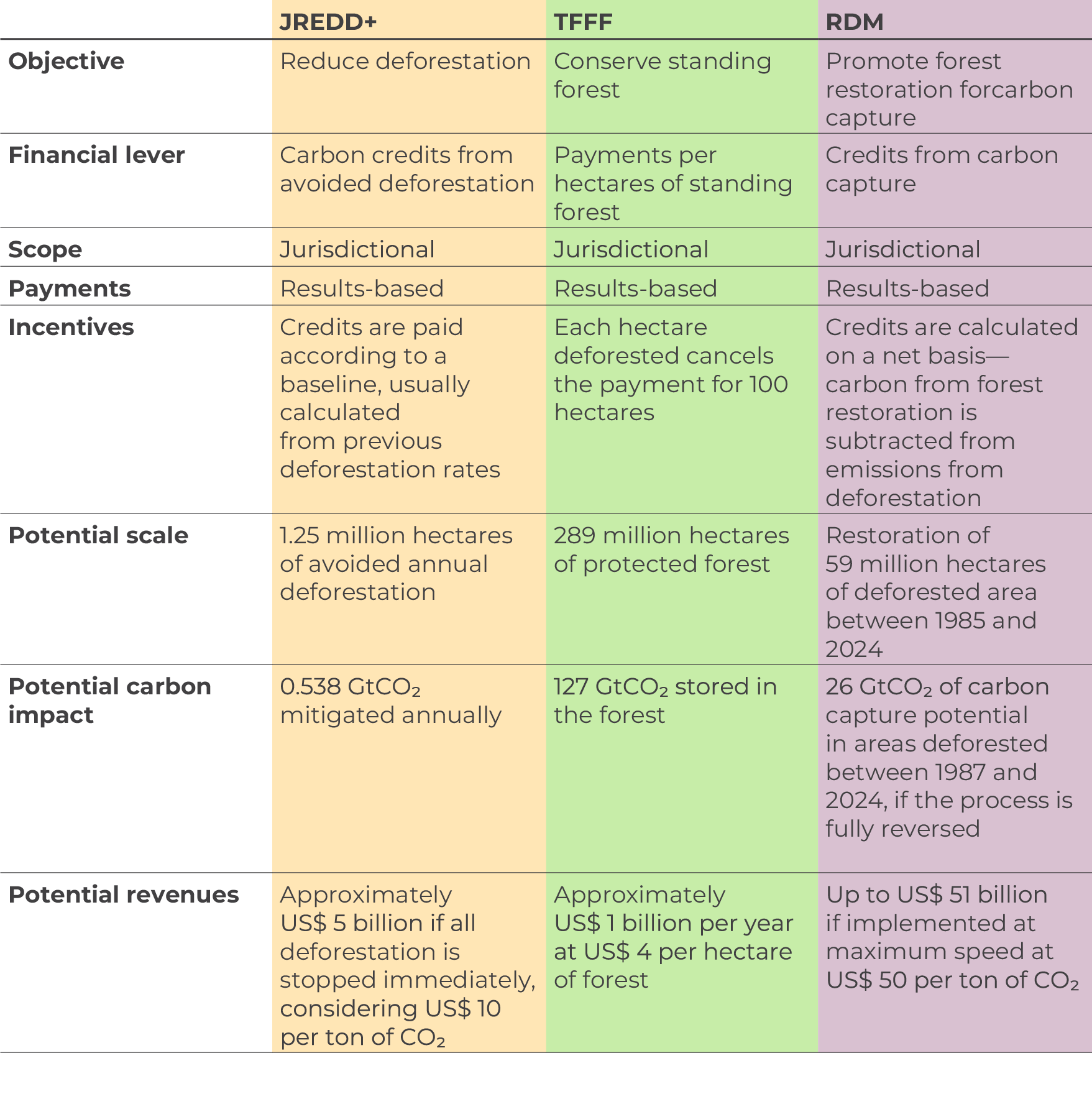
Source: CPI/PUC-RIO, 2025
Coordinating land-use planning policies with financial mechanisms like RDM, JREDD+, and TFFF, facilitates the relocation of agricultural activities to areas with greater productive potential, thus freeing up areas with greater carbon-capture potential. In addition, these mechanisms can support the implementation of Brazil’s Sectoral Nature Conservation Plan, as provided for in the country’s Climate Plan Mitigation Strategy.
These mechanisms offer significant economic potential. In the Amazon, the TFFF could generate approximately US$ 26 billion in revenue, while the RDM could reach approximately US$ 784 billion over the next 30 years, with carbon priced at US$ 50 per ton. According to Assunção, Hansen, Munson, and Scheinkman (2025), this amount would already be sufficient to achieve a land-use reallocation consistent with Brazil’s NDC. Within its first five years, the RDM alone could capture 5.3 GtCO2. In contrast, JREDD+, if operated independently, could generate just over US$ 5 billion for the Amazon through avoided deforestation.
At a reference price of US$ 10 per ton of CO2, the simulation estimates the revenue potential of JREDD+ by linking avoided deforestation to the carbon contained in the areas that would otherwise be cleared. The baseline for carbon credits corresponds to the annual average deforestation rate of 1.25 million hectares recorded between 2015 and 2024, associated with an estimated carbon stock of 54 tons of CO2 per hectare. To estimate the maximum potential of JREDD+ to curb deforestation, an extreme scenario is assumed in which all forest loss is immediately halted in the first credit period, generating a one-time payment. Multiplying the carbon density by the reference price and the annual average deforestation rate yields an estimate of the revenues that the country could earn from JREDD+ if deforestation were to cease entirely. This amount represents a one-time gain, corresponding to the immediate halt of forest loss of 1.25 million hectares and a price of US$ 10 per ton of CO2.
Just as the carbon capture potential varies between states, the financial gains are also distributed differently. In a scenario where the RDM pays US$ 50 per ton of CO2, all states receive greater revenues than under the TFFF. At a lower carbon price of US$ 25 per ton, however, Amapá becomes the only state where the TFFF yields higher benefits. Pará lead in RDM-related gains, followed by Mato Grosso, reflecting both states’ extensive deforested areas and their high potential for carbon capture through restoration. In contrast, Amazonas emerges as the main beneficiary of the TFFF due to its large remaining forest stock. Figure 8 presents the estimated values by state and the totals for the biome.
Figure 8. Present Value of JREDD+, TFFF, and RDM for the States of the Amazon Biome (US$ Billion)
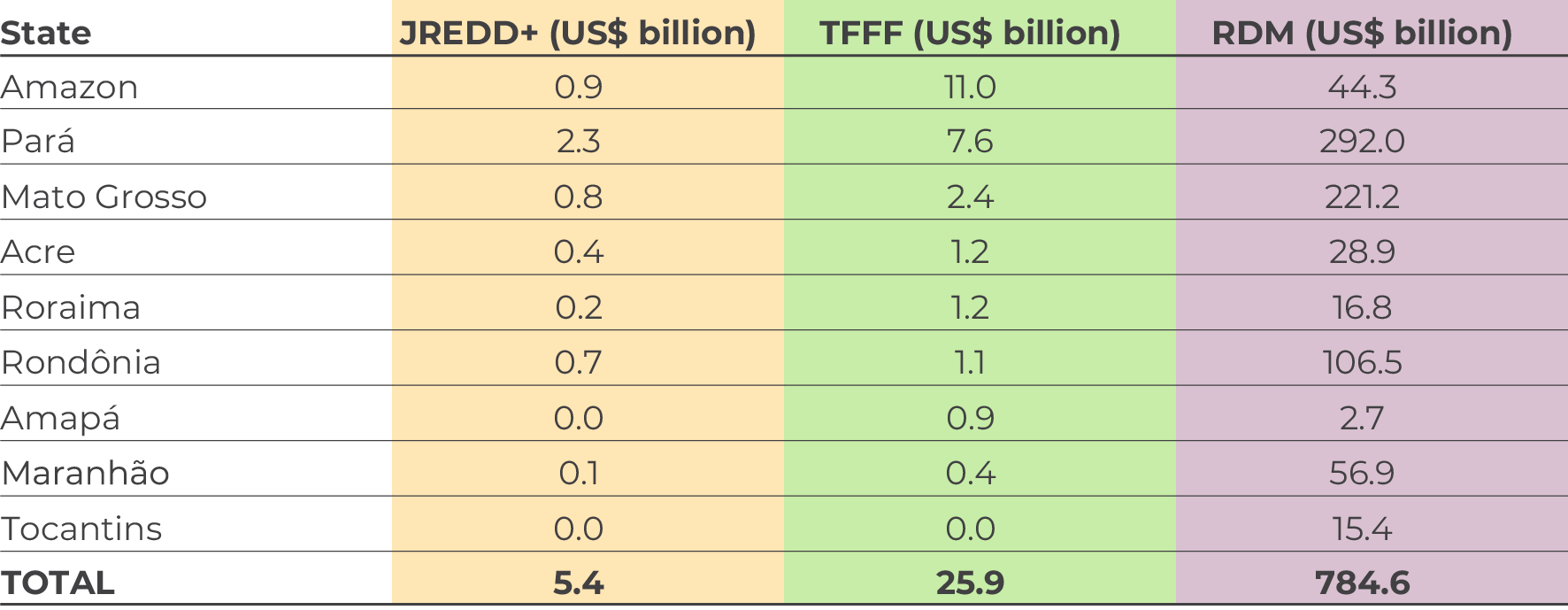
Source: CPI/PUC-RIO based on data from Hansen (2023) and MAPBIOMAS (2025), 2025
Note: The simulations used US$ 10 per ton of carbon in the case of JREDD+, US$ 50 in the case of RDM, and US$ 4 per hectare of preserved forest in the case of TFFF.
Revenues generated through these mechanisms have the potential to accelerate large-scale forest restoration and stimulate investments in agricultural productivity that are compatible with conservation goals. By financing public goods and reducing investment risks, these mechanisms can mobilize resources to amplify local economic impacts, enhance law enforcement and the management of protected areas, and strengthen the legal certainty—a key condition for attracting private capital. Together, JREDD+, TFFF, and RDM integrate the environmental and economic value of forests through complementary approaches, strengthening the Amazon’s resilience to climate change.
Pathways for Implementation
The Brazilian Amazon presents both significant risks and opportunities. From a climate perspective, ongoing deforestation threatens to push the biome toward a tipping point, compromising atmospheric regulation and biodiversity conservation. At the same time, its vast carbon stock represents one of the world’s greatest mitigation opportunities. For the region itself, forest degradation weakens ecological and economic resilience, while conservation and restoration open pathways for sustainable development.
Meeting Brazil’s NDC requires putting forests at the center of climate policy and aligning strategies to account for state-level differences in remaining forest cover, accumulated deforestation, and carbon capture potential.
In this context, international and national financial mechanisms emerge as decisive levers for implementation. The TFFF ensures financial remunerates for standing forests, supporting public policies and reducing reversal risks. JREDD+ offers results-based payments to curb deforestation. The RDM complements these mechanisms by transforming degraded areas into large-scale climate assets, generating immediate mitigation benefits and economic flows consistent with the transition to climate neutrality. Together, these mechanisms form a portfolio of integrated financial mechanisms capable of protecting and restoring the Amazon.
Brazil already possesses a strong technical and institutional foundation to operationalize the RDM and similar initiatives. This includes high-resolution satellite monitoring, deforestation alert systems, an environmental registry of private properties, successful jurisdictional experiences, and flexible funding platforms such as the Amazon Fund. These elements lower implementation risks, strengthen territorial governance, and create clear incentives to strategically direct financial resources to promote conservation, restoration, and sustainable development in the Amazon states.
By aligning financial incentives with measurable results and recognizing the complementarity between the TFFF, JREDD+, and RDM, Brazil has a unique opportunity to turn ambition into implementation. The Amazon can consolidate its role as a leader in global climate stability, delivering lasting social, economic, and environmental benefits.
This work is supported by a grant from the Institute Climate and Society (ICS), Norway’s International Forest and Climate Initiative (NICFI), Climate and Land Use Alliance (CLUA), and Porticus Foundation. This publication does not necessarily represent the view of our funders and partners.
The authors would like to thank Natalie Hoover, Paulo Barreto, and participants of the meetings of the Amazon 2030 project for their comments and suggestions. We would also like to thank Camila Calado and Maria Carolina Cassella for editing and revising the text and Meyrele Nascimento and Nina Oswald Vieira for formatting and graphic design.
[1] Pinto, Gustavo R. S. and João Pedro Arbache. When the Rivers Run Dry: How Amazon Deforestation Threatens the Brazilian economy. Rio de Janeiro: Climate Policy Initiative, 2025. bit.ly/When-The-River-Runs-Dry.
[2] Learn more at: MAPBIOMAS. More than 90% of deforestation in the Amazon is for pastures. 2024. Access date: October 7, 2025. bit.ly/3Wrhvfe.
[3] Assunção, Juliano and José A. Scheinkman. Carbon and the Fate of the Amazon. Rio de Janeiro: Climate Policy Initiative and Amazônia 2030, 2023. bit.ly/Amazon_Carbon.
[4] Franco, Marco A. et al. “How climate change and deforestation interact in the transformation of the Amazon rainforest”. Nature Communications 16, no. 7944 (2025). bit.ly/3IAbdGW.
[5] Assunção et al. The Forest-Climate Nexus: A Fit-for-Purpose Framework for Climate Impact. Rio de Janeiro: Climate Policy Initiative, 2025. bit.ly/Forest-Climate-Nexus.
[6] Assunção et al. The Forest-Climate Nexus: A Fit-for-Purpose Framework for Climate Impact. Rio de Janeiro: Climate Policy Initiative, 2025. bit.ly/Forest-Climate-Nexus.
[7] The Amazon Fund aims to raise grants for non-reimbursable investments in efforts to prevent, monitor and combat deforestation, as well as conservation and sustainable use of the Legal Amazon. Learn more at: Amazon Fund. Brazil protects it. The world supports it. Everyone wins. Access date: October 7, 2025. bit.ly/48VR2Of.
[8] ABN. COP28: Brasil anuncia R$ 1bi para Arco da Restauração, com R$ 450 mi do Fundo Amazônia. BNDES. 2023. Access date: September 10, 2025. bit.ly/4nZXGYR.
[9] The LEAF Coalition is a public-private partnership that aims to halt tropical deforestation by the year 2030. Learn more at: LEAF Coalition. What is the LEAF Coalition? Access date: October 7, 2025. bit.ly/3Wybiy6.
[10] Assunção et al. The Forest-Climate Nexus: A Fit-for-Purpose Framework for Climate Impact. Rio de Janeiro: Climate Policy Initiative, 2025. bit.ly/Forest-Climate-Nexus.
